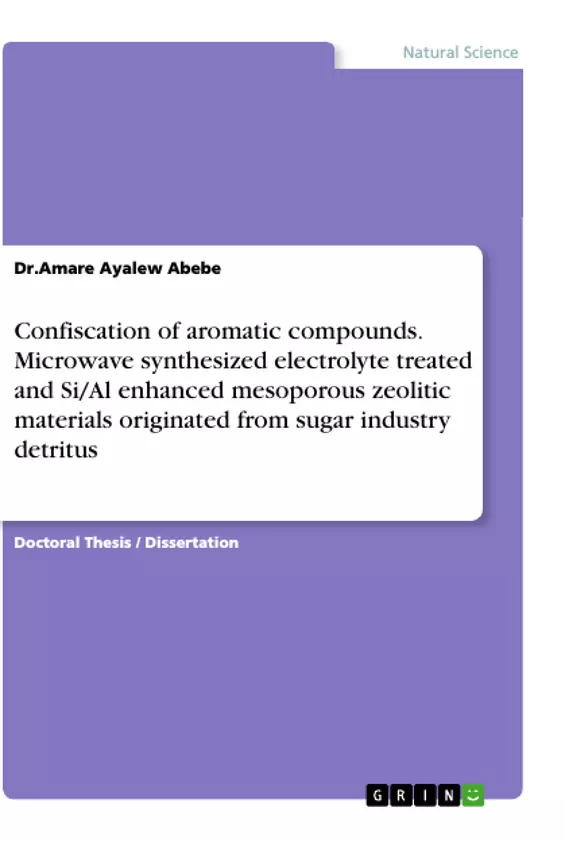The aim of this research was to synthesize and study batch properties of zeolite synthesized from Bagasse fly ash and its derived zeolitic material. To achieve this, a study was carried out with the following objectives. To synthesize zeolites from Bagasse fly ash solution via microwave assisted hydrothermal synthesis process. To study the effect of adding electrolyte and electrolyte with sodium silicate to BFA solution towards the development of zeolitic material. To investigate the effects of adding sodium hydroxide and sodium hydroxide plus sodium meta silicate for activation of BFA. To examine the structural characteristic of the synthetic zeolite produced (i.e. morphology, physico-chemical and phases identification) via XRF, SEM, FTIR, PXRD, TGA, BET and BJH and to evaluate the sorption capacity of the synthesized zeolitic material using aqueous solution of aromatic compounds
Researchers in science and engineering have increased interest in finding low-cost adsorbents such as industrial sludge waste, biomass, husk, slag, carbon slurry, bagasse fly ash (BFA), etc. to remove inorganic and organic pollutants from wastewater. There are many researcher results which were done on BFA for the removal of pesticide, dye, phenol etc but during survey of literature no research work is done on the removal of aniline, nitrobenzene and para nitroaniline using BFA and its derived zeolitic materials. Zeolites are aluminosilicates crystalline materials which contain pores and cavities of molecular dimensions. Many occur as natural minerals, but it is the synthetic varieties which are among the most widely used sorbents.
Inhaltsverzeichnis (Table of Contents)
- Introduction
- Literature survey
- Zeolite materials: Synthesis and characterization
- Microwave assisted synthesis of zeolites
- Applications of zeolites in different fields
- Sugarcane waste materials as sources for zeolites
- Experimental
- Materials and methods
- Characterization of zeolites
- Adsorption studies
- Results and discussion
- Characterization of zeolites
- Adsorption studies
- Conclusions
Zielsetzung und Themenschwerpunkte (Objectives and Key Themes)
This thesis focuses on the development of cost-effective and environmentally friendly methods for the synthesis of mesoporous zeolitic materials from sugarcane industry detritus. The research aims to investigate the potential of these materials for the adsorption and removal of aromatic compounds from contaminated water sources.
- Synthesis of mesoporous zeolites from sugarcane industry detritus
- Microwave-assisted synthesis of zeolites
- Characterization of the synthesized materials
- Adsorption studies of aromatic compounds on the zeolites
- Evaluation of the potential of the zeolites for environmental remediation
Zusammenfassung der Kapitel (Chapter Summaries)
The introduction provides an overview of the background and significance of the research, outlining the importance of zeolites and their potential applications in environmental remediation. The literature survey reviews existing research on the synthesis, characterization, and applications of zeolites, with particular emphasis on microwave-assisted synthesis and the use of sugarcane waste materials as sources for zeolite synthesis.
The experimental chapter details the materials and methods used in the research, covering the synthesis procedures for the zeolites, their characterization techniques, and the adsorption studies conducted. The results and discussion section presents the findings of the research, analyzing the characterization data and the adsorption behavior of the synthesized zeolites towards aromatic compounds.
Schlüsselwörter (Keywords)
The research focuses on the synthesis and characterization of mesoporous zeolites from sugarcane industry detritus, their potential for the adsorption of aromatic compounds, and their application in environmental remediation. Key terms include: mesoporous zeolites, sugarcane industry detritus, microwave synthesis, adsorption, aromatic compounds, environmental remediation.
- Arbeit zitieren
- Dr.Amare Ayalew Abebe (Autor:in), 2016, Confiscation of aromatic compounds. Microwave synthesized electrolyte treated and Si/Al enhanced mesoporous zeolitic materials originated from sugar industry detritus, München, GRIN Verlag, https://www.grin.com/document/997878



